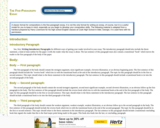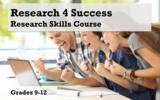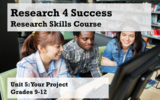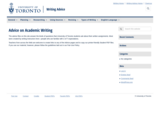
A screencast lesson explaining common errors when writing an introduction and how to avoid them. [8:19]
- Subject:
- Arts
- English Language Arts
- Material Type:
- Audio/Video
- Provider:
- Sophia Learning
- Date Added:
- 12/01/2023

A screencast lesson explaining common errors when writing an introduction and how to avoid them. [8:19]

This tutorial on writing essays contains several sections pertaining to the thesis. These include thesis definition, characteristics, analysis of thesis to gather and shape information, and topic sentences. Many examples given. W.9-10.2 Informative, W.11-12.2 Informative, W.11-12.2a Intro/Format

Explains what each paragraph of the five-paragraph essay, should do. Then gives a side-by-side analysis of a sample essay, pointing out aspects of the introduction and thesis statement, the paragraph-by-paragraph development, and the conclusion.

Superbly written explanation of thesis development. Use the links on the right to work through the writing process.

An adult educator talks about the thesis statement and how to cluster ideas around it.

This tutorial lists and discusses the steps to writing a good essay and provides a downloadable guide. It also allows you to view a sample essay. W.11-12.2a Intro/Format

This online writing assistance offers help in the writing process, grammar and mechanics, usage, and four different types of essays, as well as help on deciding what and how to document.

A great resource for middle-school, high-school, and college writers, with worksheets, articles, model papers, and presentations that will help you with research, grammar, style, job-search and professional writing, and more. Includes resources for teachers and for ESL.

Welcome to Research 4 Success (R4S)! The course is designed to supplement the instruction of research and information literacy skills for students in grades 9-12. Purpose and Design of the CourseR4S consists of six learning units. The six units can be used together or they can be used individually. Each unit contains three lessons. Each lesson has resources and activities to supplement the instruction of research, inquiry, and information literacy skills.Students learn key skills using a combination of videos, digital texts, and eBooks.Students practice key skills using a combination of templates, tasks, and interactives. Students apply the skills they have learned and practice as they develop a research project under the guidance of an educator.

You have found your sources. You have taken good notes and organized your information. You have an idea you want to share. The next step is polishing it up for others to see. You will need to choose the best way to share your new knowledge with your audience. Remember to give credit to the original author of any work - music, video, writing, or even a game.Each lesson includes activities and resources selected to help students learn, practice, and apply research skills. Students learn how to develop a thesis statement and use citations, practice developing a topic with reason and evidence, and apply strategies and tools to produce, publish, and share research.

Students learn how to develop a thesis statement and use citations.

Written by a college professor, this site discusses five areas for students to work on to improve their writing. The areas are Thesis, Research, Close Reading, Style, and Mechanics. The author is clear and concise in his advice, and often uses humor to make his points. Well-done and thorough.

Brief explanation of the thesis statement, followed by examples of faulty and improved thesis statements.

Readable, but thorough handout on the thesis statement. Covers what it is, why it's important, how to come up with one, examples, and how to evaluate. Bibliography included. W.9-10.2a Intro/org/graphics

This University of North Carolina writing tutorial gives examples and how to use transitions and stresses the importance of organization. W.9-10.1c cohesion/clarity/reason, W.9-10.2c cohesion/clarity/trans, W.11-12.1c Transitions/Cohesion, W.11-12.2c Transition/Cohesion CCSS.ELA-Literacy.WHST.6-8.2.c

This site has an examination of five different thesis statements with examples of how to write each of the statements.

The first part of this page lists five characteristics of a thesis statement and gives examples of a poor and an effective statement for each characteristic. The second part of the handout dispels common myths about the thesis statement.

Explains the thesis statement and distinguishes it from the purpose statement. Gives an example of a paragraph containing both. Be sure try the link at the bottom of the page, "Developing a Thesis Statement." This page goes into further detail explaining the thesis, gives five strategies for developing the thesis, and shows how a thesis statement can be refined.